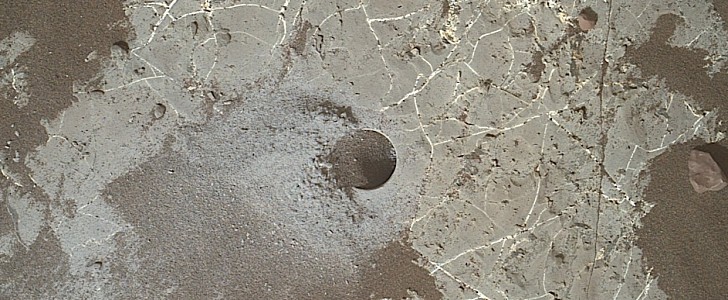Thanks to the countless images of the Red Planet sent back by the HiRISE camera over the years, space enthusiasts here on Earth have a pretty good idea of what the place looks like. Sure, a few tens of thousands of images from space are not nearly enough to paint a comprehensive image of an entire world, but they are enough for us to get the gist.
Usually shot from 100+ miles above the surface, the HiRISE images, a bunch of which we’ve seen here on autoevolution as well, do have one major shortcoming: they lack a point of comparison for scale, and that means we generally don’t get a sense of size.
HiRISE pics generally show an area 5 km (3.1 miles) across, which by our standards is quite a solid chunk of alien world. Inside those 3 or so miles, worlds of wonders hide, from remnants of ancient impacts to possible traces of water and life.
The main photo of this piece shows a portion of Mars as well. For all intents and purposes, it looks like most others we’ve seen before, with what appear to be rock outcroppings, patches of sand, fractures of some sorts, and even impact craters and hills.
The reality is the image shows none of that. It couldn’t, given how this one is only a few inches across and was taken by the Curiosity rover so that the robot’s operators could brag about a perfectly round hole (smack down in the center of the image) the robot dug into the ground.
This particular hole is named Highfield (yes, there are so few of them they have names), and is located somewhere in the Gale crater on Mars. The samples extracted and analyzed by the rover showed the presence of “carbon 12, a type of carbon that on Earth is associated with biological processes.”
“While the finding is intriguing, it doesn’t necessarily point to ancient life on Mars, as scientists have not yet found conclusive supporting evidence of ancient or current biology there, such as sedimentary rock formations produced by ancient bacteria, or a diversity of complex organic molecules formed by life,” NASA says.
HiRISE pics generally show an area 5 km (3.1 miles) across, which by our standards is quite a solid chunk of alien world. Inside those 3 or so miles, worlds of wonders hide, from remnants of ancient impacts to possible traces of water and life.
The main photo of this piece shows a portion of Mars as well. For all intents and purposes, it looks like most others we’ve seen before, with what appear to be rock outcroppings, patches of sand, fractures of some sorts, and even impact craters and hills.
The reality is the image shows none of that. It couldn’t, given how this one is only a few inches across and was taken by the Curiosity rover so that the robot’s operators could brag about a perfectly round hole (smack down in the center of the image) the robot dug into the ground.
This particular hole is named Highfield (yes, there are so few of them they have names), and is located somewhere in the Gale crater on Mars. The samples extracted and analyzed by the rover showed the presence of “carbon 12, a type of carbon that on Earth is associated with biological processes.”
“While the finding is intriguing, it doesn’t necessarily point to ancient life on Mars, as scientists have not yet found conclusive supporting evidence of ancient or current biology there, such as sedimentary rock formations produced by ancient bacteria, or a diversity of complex organic molecules formed by life,” NASA says.






